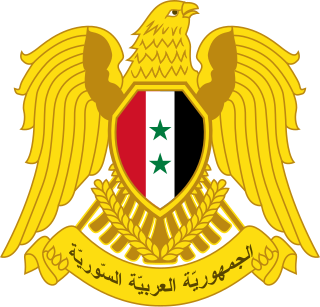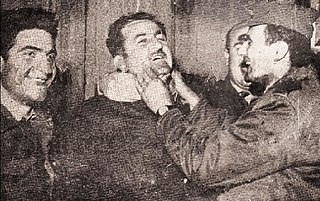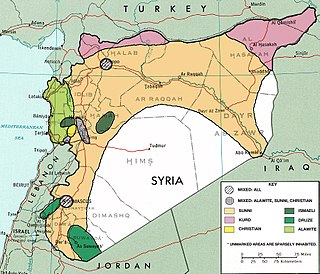
Politics in the Syrian Arab Republic takes place in the framework of a presidential republic with nominal multi-party representation in People's Council under the Ba'athist-dominated National Progressive Front. In practice, Syria is a one-party state where independent parties are outlawed; with a powerful secret police that cracks down on dissidents. Since the 1963 seizure of power by its Military Committee, the Arab Socialist Ba'ath Party has governed Syria as a totalitarian police state. After a period of intra-party strife, Hafez al-Assad gained control of the party following the 1970 coup d'état and his family has dominated the country's politics ever since.

The Syrian Arab Armed Forces are the military forces of the Syrian Arab Republic. They consist of the Syrian Army, Syrian Air Force, Syrian Navy, Syrian Air Defense Force, and paramilitary forces, such as the National Defence Forces. According to the Constitution of Syria, the President of Syria is the Commander-in-chief of the Armed Forces. Minister of Defense holds the position of Deputy Commander-in-chief of the Army and Armed Forces.

Bashar al-Assad is a Syrian politician who is the 19th and current president of Syria since 2000. In addition, he is the commander-in-chief of the Syrian Armed Forces and the secretary-general of the Central Command of the Arab Socialist Ba'ath Party. He is a son of Hafez al-Assad, who was President of Syria from 1971 to 2000.

Human rights in Syria are effectively non-existent. The country's human rights record is considered one of the worst in the world. As a result, Syria has been globally condemned by prominent international organizations, including the United Nations, Human rights Watch, Amnesty International, and the European Union. Civil liberties, political rights, freedom of speech and assembly are severely restricted under the Ba'athist government of Bashar al-Assad, which is regarded as "one of the world's most repressive regimes". The 50th edition of Freedom in the World, the annual report published by Freedom House since 1973, designates Syria as "Worst of the Worst" among the "Not Free" countries. The report lists Syria as one of the two countries to get the lowest possible score (1/100).

Syria, officially the Syrian Arab Republic, is a country in West Asia located in the Eastern Mediterranean and the Levant. It is bounded by the Mediterranean Sea to the west, Turkey to the north, Iraq to the east and southeast, Jordan to the south, and Israel and Lebanon to the southwest. It is a republic that consists of 14 governorates as subdivisions. Damascus is Syria's capital and largest city. With a population of 24.8 million, it is the 57th most populous country in the world and 8th most populuous in the Arab world. Syria is spread across an area of 185,180 square kilometres (71,500 sq mi), making it 87th largest country in the world.

The 1963 Syrian coup d'état, referred to by the Syrian government as the March 8 Revolution, was the seizure of power in Syria by the military committee of the Syrian Regional Branch of the Arab Socialist Ba'ath Party. The planning and the unfolding conspiracy of the Syrian Ba'athist operatives were prompted by the Ba'ath party's seizure of power in Iraq in February 1963.

The Syrian civil war is an ongoing multi-sided conflict in Syria involving various state-sponsored and non-state actors. In March 2011, popular discontent with the rule of Bashar al-Assad triggered large-scale protests and pro-democracy rallies across Syria, as part of the wider Arab Spring protests in the region. After months of crackdown by the government's security apparatus, various armed rebel groups such as the Free Syrian Army began forming across the country, marking the beginning of the Syrian insurgency. By mid-2012, the crisis had escalated into a full-blown civil war.
The 2004 Qamishli riots were an uprising by Syrian Kurds in the northeastern city of Qamishli in March 2004, which culminated in a massacre by the Syrian Arab Armed Forces.
This is a broad timeline of the course of major events of the Syrian civil war. It only includes major territorial changes and attacks and does not include every event.

The Arab Socialist Ba'ath Party, also referred to as the pro-Syrian Ba'ath movement, is a neo-Ba'athist political party with branches across the Arab world. The party emerged from a split in the Ba'ath Party in February 1966 and leads the government in Syria. From 1970 until 2000, the party was led by the Syrian president and Secretary General Hafez al-Assad. Until October 2018, leadership has been shared between his son Bashar al-Assad and Abdullah al-Ahmar. In 2017, after the reunification of the National and Regional Command, Bashar al-Assad became the Secretary General of the Central Command. The Syrian branch of the Party is the largest organisation within the Syrian-led Ba'ath Party.

The Syrian Civil War is an intensely sectarian war. However, the initial phases of the uprising in 2011 featured a broad, cross-sectarian opposition to the rule of Bashar al-Assad, reflecting a collective desire for political reform and social justice, transcending ethnic and religious divisions. Over time, the civil war has largely transformed into a conflict between ruling minority Alawite government and allied Shi'a governments such as Iran; pitted against the country's Sunni Muslim majority who are aligned with the Syrian opposition and its Turkish and Persian Gulf state backers. Sunni Muslims make up the majority of the Syrian Arab Army (SAA) and many hold high administrative positions, while Alawites and members of almost every minority have also been active on the rebel side.

Syria and Iran are strategic allies. Syria is usually called Iran's "closest ally", notwithstanding the conflict between the Arab nationalism ideology of Syria's secular ruling Ba'ath Party and the Islamic Republic of Iran's pan-Islamist policy. Iran and Syria have had a strategic alliance ever since the Iran–Iraq War, when Syria sided with non-Arab Iran against neighbouring Ba'ath-ruled Iraq. The two countries shared a common animosity towards then-Iraqi president Saddam Hussein and coordination against the United States and Israel.
The Axis of Resistance is a network of Iranian-backed militias and political groups in the Middle East, formed by Iran by uniting and grooming armed groups that are dedicated to confront the influence of United States and Israel in the Middle East, and shares hostility toward the countries. The U.S. designates most of these groups as terrorist organizations.

Hafez al-Assad served as the President of Syria from 12 March 1971 until his death on 10 June 2000. He had been Prime Minister of Syria, leading a government for two years. He was succeeded by his son, Bashar al-Assad.

The history of Syria covers events which occurred on the territory of the present Syrian Arab Republic and events which occurred in the region of Syria. Throughout ancient times the territory of present Syrian Arab Republic was occupied and ruled by several empires, including the Sumerians, Mitanni, Assyrians, Babylonians, Egyptians, Hittites, Canaanites, Phoenicians, Arameans, Amorites, Persians, Greeks and Romans. Syria is considered to have emerged as an independent country for the first time on 24 October 1945, upon the signing of the United Nations Charter by the Syrian government, effectively ending France's mandate by the League of Nations to "render administrative advice and assistance to the population" of Syria, which came in effect in April 1946.

Hezbollah involvement in the Syrian civil war has been substantial since the beginning of armed insurgency phase of the Syrian civil war in 2011, and evolved into active support for Syrian government forces and troop deployment from 2012 onwards. By 2014, Hezbollah was deployed across Syria. Hezbollah has also been very active in preventing Al-Nusra Front and Islamic State penetration into Lebanon, being one of the most active forces in the Syrian civil war spillover in Lebanon.
The following is a timeline of the Syrian Civil War from May to August 2017. Information about aggregated casualty counts is found at Casualties of the Syrian Civil War.

The 2012–2013 escalation of the Syrian Civil War refers to the third phase of the Syrian Civil War, which gradually escalated from a UN-mediated cease fire attempt during April–May 2012 and deteriorated into radical violence, escalating the conflict level to a full-fledged civil war.

The Eagles of the Whirlwind are the armed wing of the Syrian Social Nationalist Party. Around 6,000 to 8,000 men strong, they participated in many battles and operations throughout the Syrian Civil War fighting alongside the Syrian government and its allies.
Syrian foreign policy during the presidency of Bashar al-Assad is based on continuity from the Cold War-era policies of his father and predecessor, Hafiz al-Assad. Hafiz al-Assad was a strong supporter of Soviet Union and aligned Ba'athist Syria closely with the Eastern Bloc. During this period, Syria adopted a strong anti-Zionist posture in the region, based on its military doctrine of gaining "strategic parity" and forming joint Arab initiatives.


























